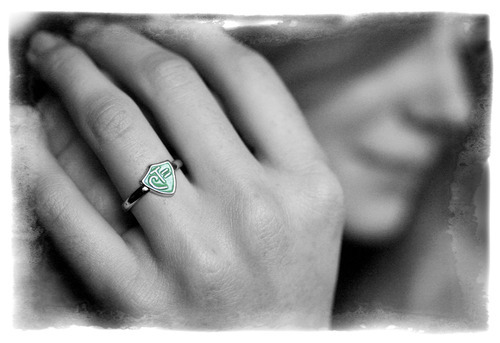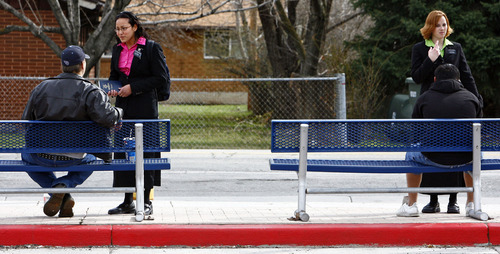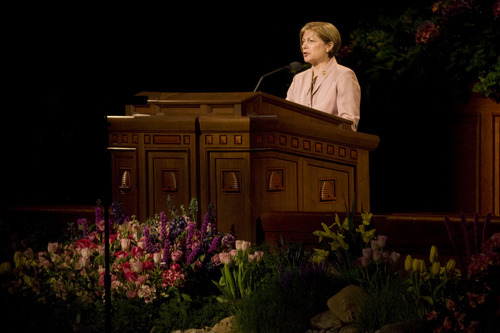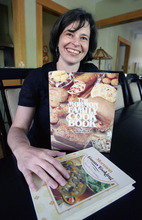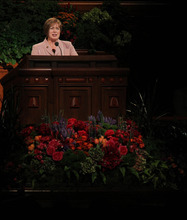This is an archived article that was published on sltrib.com in 2012, and information in the article may be outdated. It is provided only for personal research purposes and may not be reprinted.
For some Mormon feminists, there can be only one goal on the road to gender equality: priesthood ordination.
After all, every worthy male in the lay-clergy-run Church of Jesus Christ of Latter-day Saints — starting at age 12 — is ordained in this priesthood. It is seen as a holy power, described as the authority to act in God's name, yet given exclusively to men.
At the same time, lots of LDS women are perfectly comfortable with the roles they believe God assigned to them, including motherhood and nurturing. They would not want, they say, to "hold the priesthood."
Now comes a third and, some suggest, growing group of women somewhere between these two poles.
They are not pushing for ordination, but they crave a more engaged and visible role for women in the Utah-based LDS Church. It is a role, they believe, their Mormon foremothers played — and one that could fit easily into the institutional structure without distorting or dismantling doctrine.
These women — some of whom consider themselves feminists, while others avoid that label — point to little changes that would pay big dividends: treating a stake Relief Society president much as her male counterpart and assigning her to be a regular speaker at stake conferences and in ward worship services; quoting more women in sermons and Sunday School lessons; selecting more women to speak and pray at churchwide General Conferences; letting women either conduct (or at least be present at) worthiness interviews for teen girls; choosing strong General Relief Society presidents and allowing them to serve longer and become more visible in the church; and permitting women to serve as mission zone leaders, ward clerks and other traditionally male positions.
Many of them agree that no meeting should take place in which decisions about women are made without a woman being present.
Talk about such changes is buzzing around the Mormon bloggernacle and was discussed at a recent gathering of FAIR (the Foundation for Apologetic Information and Research). It has spawned websites such as Mormon Women Project, which publishes interviews with strong LDS women from around the globe and the creation of a blog called Young Mormon Feminists by a Brigham Young University student. It has led to the revival of Exponent II, modeled after a 19th-century LDS women's magazine, and was the topic of a monthly podcast that included the founders of several LDS women's groups, including Feminist Mormon Housewives, LDS WAVE and The Power of Moms.
Next week, the church's History Department is joining with the University of Utah and several other groups to sponsor a symposium, "Women and the LDS Church."
"There is a tremendous amount of pain among our women regarding how they can or cannot contribute to the governance of our ecclesiastical organization," Neylan McBaine, founder of the Mormon Women Project, said at the FAIR conference. "We need to pay attention to that pain. … The pain is real."
These LDS women, McBaine said, are not trying to "eradicate the divine differences between men and women," but want to be "used, engaged, recognized and appreciated … in the broadest context of the Lord's kingdom."
If Mormonism's first generation of strong and charismatic female leaders had seen this era, the modern women wonder, what would they think has happened to their legacy?
—
Priests and priestesses • In the 19th century, many Mormon women had a strong sense of partnership within the priesthood. They were outspoken leaders of female organizations who oversaw their own finances, programs and publishing. They gave healing blessings to other women and their offspring. They spoke openly of women's spiritual powers and being the offspring of heavenly parents — one of them God the Mother.
Mormon women were early suffragettes, forming alliances with national leaders such as Elizabeth Cady Stanton and Susan B. Anthony. They were the first in the nation to vote and among the trailblazers to pursue professional careers in medicine, business and law.
Into the 20th century, LDS leaders such as Amy Brown Lyman commanded much respect, building hospitals and working on alleviating poverty and illiteracy. After World War II, Relief Society General President Belle Spafford helped with global aid efforts. She remained in that position for nearly 30 years, serving as president of the National Council of Women from 1968 to 1970.
In April, the Relief Society lost a strong, distinctive voice when its general president, Julie B. Beck, was released after just five years — a rotation that has become the norm for such positions.
Beck's replacement, Linda K. Burton, declined to be interviewed for this story. Right now, there are no official female spokeswomen for the church.
For Laurel Thatcher Ulrich, who teaches history at Harvard, this is Mormonism's most pressing gender issue — what she calls "the great disappearance."
"I see articulate, spiritually aware, productive, loving and amazingly resilient women in my ward [congregation]. Every Sunday I hear their voices, listen to their talks, learn from their lessons, mix with them in meetings and in the foyer, and see them doing amazing things," Ulrich writes in an email from Boston. "But, for some reason, we get only token acknowledgment of women beyond the ward."
She has attended entire LDS stake conferences — which include members from several wards — in which "men did all the talking (except occasionally for the wife of the mission president)."
Women have "only token participation" in the church's semiannual General Conferences and "have largely been erased from our [doctrinal] manuals. They show up in the Ensign [the church's official magazine] in very limited ways," Ulrich says. "Even the Relief Society visiting teaching messages primarily quote men."
A recent churchwide publication, Daughters in My Kingdom: The History and Work of Relief Society, featured profiles and writing from earlier Mormon women, she says, "but as far as I can tell it has no acknowledged place in the curriculum."
This "strange, new phenomenon" of the disappearing women "is so at odds with my early experience in the church, my understanding of the gospel, and of what looks to me like simple common sense that I am simply stunned that it persists," Ulrich writes. "The sad thing is, many young women in the church have never experienced anything else."
—
Generational issue • Kristine Haglund, editor of Dialogue: A Journal of Mormon Thought, also worries about the impact on younger LDS women.
"The limited vision of women's roles that Mormonism imported from post-World War II American culture is unappealing and uninspiring for many young women," Haglund writes in an email. "We must articulate a Mormonism that is less about lifestyle choice and more about spiritual power and a personal relationship with God that can enlighten all the facets of the lives young women choose for themselves."
Mormon women yearn to be more useful in the faith "to bless the lives of women throughout the world, particularly in the global south," Haglund says, "and, in turn, incorporate the wisdom of women from outside of the United States into our curricula and leadership."
Women have become "the support staff for the real work of men," says LDS activist and writer Chelsea Shields Strayer, "which means we are basically working with only 50 percent of our human capital."
It is essential, says Strayer from Baltimore, "to open up new arenas for women to have stewardship, autonomy and trust their own revelation."
That might help deal with some of the LDS Church's other gender issues, she says, such as the "inappropriateness of young girls confessing sexual sins to their male bishops, all-male disciplinary councils and the lack of women's voices in religious text, curriculum and decision-making bodies."
It is time, these women say, to expand opportunities and experiences available to Mormon women.
But what about the church's 1995 family proclamation, with its detailed descriptions of men as providers and women as nurturers?
Those who have "issues with the Proclamation on the Family deserve to be heard," says Margaret Young, a BYU English professor. "The role definition in that document troubles many women. Might that be a document which could use more female input and even a rewrite, since it has not yet been declared official revelation, nor (as far as I know) has yet had female input?"
Young says in her own moments of trouble, she turns to other women.
"I have lunch with other mothers who are meeting great challenges in their parenting, and we comfort and support one another," she says. "I would like to feel that same sense in General Conference — and from a woman's voice."
Young sees a powerful sense of male/female equality in LDS temple rituals.
"Because I am an ordinance worker, I do many things with authority in the temple," she says. "I believe that I hold the priesthood jointly with my husband and would like to be considered his equal in blessing our children when they're ill or needing comfort. That simply feels right to me, that we, as parents, lay our hands on our children's heads."
Plus, Young would like to follow the example of her female progenitors — blessing daughters before they give birth.
"There is something beautiful," she says, "about a woman blessing the one whom she herself delivered before."
In the current system, though, could anyone do that without priesthood power?
—
A kind of power • Despite the lack of contemporary role models, Mormonism does teach that women have access to all the same revelatory and healing powers as men, just with their own faith, not priesthood authority.
"Spiritual gifts, which have been a hallmark of this church from its very inception, are given equally to men and women," Bonnie Atkinson, a Mormon writer and blogger in Springville, writes in an email. "That's the more crucial equality, the eternal equality that supersedes any secular definition of equality."
Atkinson argues that LDS women are not taking advantage of powers they already possess.
Mormon women need to "step forward and embrace these gifts of the spirit, acknowledge the value of what they are already doing, and ask more of themselves," Atkinson says. Then the outside world "will take notice of their articulateness, skills and worth. It won't be because a policy or a program changed to bestow that power on them."
Strayer notes that Mormons have "a uniquely feminist doctrine that … could be an example of religious gender equality to every other world religion. However, I don't see that doctrine being expanded or even pondered in this generation."
Is female ordination, then, an unreasonable hope?
"My own view is that ordination to priesthood office is neither a necessary nor a sufficient condition," Haglund writes, "for making the kinds of changes that would allow women to participate fully in the life of the church."
Instead, women can tap the flexibility of being largely "off the chart" in terms of organization, she says, using women's informal networks to "transmit knowledge in ways that seem better suited to an information age than the formal and sometimes cumbersome 'priesthood channels.' "
Other Mormon women see no possibility of equality without ordination.
"I have personally come to believe in a priestesshood that is extended to women when they go through the temple," writes LDS WAVE founder Tresa Edmunds. "But I also believe that … as long as church leadership is contingent upon the priesthood, women will be marginalized in the gospel. … For women to be truly equal in the church, bureaucratic leadership needs to be completely uncoupled from priesthood ordinances, or women need to have access to fulfill those ordinances."
Hannah Wheelwright, a BYU sophomore majoring in political science who launched the Young Mormon Feminists blog, says the church could do a lot to "decrease gender inequality," such as "allowing women into the governance of the church" or considering the General Relief Society and Primary presidencies to be "general authorities."
With no significant Mormon female spiritual leaders, Wheelwright says, "I fail to see how women are equal. Female ordination is the only ultimate signal of equality."
Jana Riess, a Mormon writer in Cincinnati, reluctantly agrees.
"For the last 90 years, everything has been channeled through the priesthood — all decision-making, rituals, everything that goes on in Mormon life," Riess says. "Women are completely shut out from having input into decision-making that affects their lives and their families."
Riess is reconciled to the idea that she doesn't need the priesthood to enjoy the rituals, but is deeply troubled that "women are so systematically underutilized."
She sees two paths forward: Women either get the priesthood or the priesthood is expanded to accommodate greater involvement and visibility for women.
That large middle group seems to be pushing for the latter.


